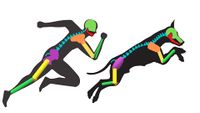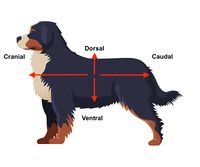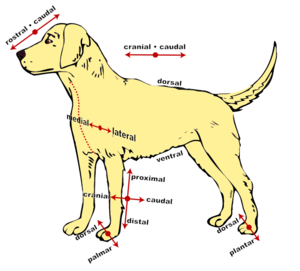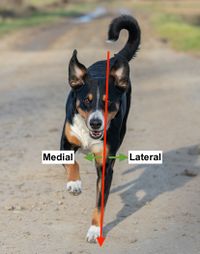Introduction to Quadruped Anatomical Terminology: Difference between revisions
No edit summary |
No edit summary |
||
| (3 intermediate revisions by 2 users not shown) | |||
| Line 4: | Line 4: | ||
== Terminology == | == Terminology == | ||
Many veterinary anatomical terms are similar to those used in human anatomy, but there are some important terms to know if you are working with animals. | Many veterinary anatomical terms are similar to those used in human anatomy, but there are some important terms to know if you are working with animals. | ||
[[File:Anatomy Animals vs Humans.jpg|thumb|200x200px]] | [[File:Anatomy Animals vs Humans.jpg|thumb|200x200px|alt=|Anatomy Animals vs Humans]] | ||
'''Animals stand on all fours:'''<ref name=":1">Prydie D, Hewitt I editors.Practical Physiotherapy for Small Animal Practice. Chichester: John Wiley & Sons, Ltd, 2015.</ref> | '''Animals stand on all fours:'''<ref name=":1">Prydie D, Hewitt I editors.Practical Physiotherapy for Small Animal Practice. Chichester: John Wiley & Sons, Ltd, 2015.</ref> | ||
* Anterior in humans = cranial in animals | * Anterior in humans = cranial in animals | ||
| Line 10: | Line 10: | ||
* Ventral in humans – towards the front (palm), ventral in animals = directed towards the ground | * Ventral in humans – towards the front (palm), ventral in animals = directed towards the ground | ||
* Dorsal in humans - towards the back, dorsal in animals = directed towards the spine | * Dorsal in humans - towards the back, dorsal in animals = directed towards the spine | ||
For instance the cranial cruciate ligament in dogs is the same as the “anterior” cruciate ligament (ACL) in humans. | For instance the cranial cruciate ligament in dogs is the same as the “anterior” cruciate ligament ([[Anterior Cruciate Ligament (ACL)|ACL]]) in humans. <ref>Spinella G, Arcamone G, Valentini S. [https://www.ncbi.nlm.nih.gov/pmc/articles/PMC8472898/pdf/vetsci-08-00186.pdf Cranial Cruciate Ligament Rupture in Dogs: Review on Biomechanics, Etiopathogenetic Factors and Rehabilitation.] Vet Sci. 2021 Sep 6;8(9):186. </ref> The caudal cruciate ligament in dogs is the same as the “posterior” cruciate ligament ([[Posterior Cruciate Ligament|PCL]]) in humans[[File:Quadruped terminology from the side.jpg|thumb|200x200px|alt=|Quadruped terminology]] | ||
'''Animals are quadripedal''' – i.e. their vertebral column is parallel to the ground:<ref name=":1" /> | '''Animals are quadripedal''' – i.e. their vertebral column is parallel to the ground:<ref name=":1" /> | ||
* Head is cranial | * Head is cranial | ||
| Line 22: | Line 22: | ||
'''Terminology referring to the thoracic or forelimb:'''<ref name=":1" /> | '''Terminology referring to the thoracic or forelimb:'''<ref name=":1" /> | ||
[[File:Quadruped Anatomical-directions.png|thumb|300x300px]] | [[File:Quadruped Anatomical-directions.png|thumb|300x300px|alt=|Quadruped Anatomical-directions]] | ||
* Dorsal – cranial face of the distal part of the forelimb or dorsum of the manus (i.e. the section from the carpus down) | * Dorsal – cranial face of the distal part of the forelimb or dorsum of the manus (i.e. the section from the carpus down) | ||
* Palmar (volar) - opposite to the dorsal surface | * Palmar (volar) - opposite to the dorsal surface | ||
| Line 36: | Line 36: | ||
* Pes – the section of the hindlimb from the tarsus down | * Pes – the section of the hindlimb from the tarsus down | ||
* Tibial – the side of the leg where the tibia is located (medial) | * Tibial – the side of the leg where the tibia is located (medial) | ||
*[[File:Quadruped terminology from the front.jpg|thumb|254x254px]]Fibular – the side of the leg where the fibula is located (lateral) | *[[File:Quadruped terminology from the front.jpg|thumb|254x254px|alt=|Quadruped terminology]]Fibular – the side of the leg where the fibula is located (lateral) | ||
'''This short video will describe more:''' | '''This short video will describe more:''' | ||
{{#ev:youtube|nKYmpzmiwzI|250}} <div class="text-right"><ref>atdove.org. Directional Terms in Veterinary Medicine. 2017. Available from: https://youtu.be/nKYmpzmiwzI</ref></div> | {{#ev:youtube|nKYmpzmiwzI|250}} <div class="text-right"><ref>atdove.org. Directional Terms in Veterinary Medicine. 2017. Available from: https://youtu.be/nKYmpzmiwzI</ref></div> | ||
| Line 55: | Line 55: | ||
== Additional Resource == | == Additional Resource == | ||
{{#ev:youtube|T8pCS4rdm38|250}} <div class="text-right"><ref>Rod Allrich. Directional Terms Used in Animal Anatomy. Available from: https://www.youtube.com/watch?v=T8pCS4rdm38 [last accessed 4/1/20201]</ref></div> | {{#ev:youtube|T8pCS4rdm38|250}} <div class="text-right"><ref>Rod Allrich. Directional Terms Used in Animal Anatomy. Available from: https://www.youtube.com/watch?v=T8pCS4rdm38 [last accessed 4/1/20201]</ref><br /></div> | ||
== References == | == References == | ||
| Line 63: | Line 61: | ||
[[Category:Animal Physiotherapy]] | [[Category:Animal Physiotherapy]] | ||
[[Category:Course Pages]] | [[Category:Course Pages]] | ||
[[Category: | [[Category:Plus Content]] | ||
Latest revision as of 23:02, 31 December 2022
Top Contributors - Tarina van der Stockt, Kim Jackson, Lucinda hampton and Ewa Jaraczewska
Terminology[edit | edit source]
Many veterinary anatomical terms are similar to those used in human anatomy, but there are some important terms to know if you are working with animals.
Animals stand on all fours:[1]
- Anterior in humans = cranial in animals
- Posterior in humans = caudal in animals
- Ventral in humans – towards the front (palm), ventral in animals = directed towards the ground
- Dorsal in humans - towards the back, dorsal in animals = directed towards the spine
For instance the cranial cruciate ligament in dogs is the same as the “anterior” cruciate ligament (ACL) in humans. [2] The caudal cruciate ligament in dogs is the same as the “posterior” cruciate ligament (PCL) in humans
Animals are quadripedal – i.e. their vertebral column is parallel to the ground:[1]
- Head is cranial
- Tail is caudal
- Within the head, rostral refers to structures closer to the nose
Terminology relevant to the limbs:[1]
- Proximal - the parts of the limbs that are nearest to the body
- Distal - the part of a structure that is furthest away from the main mass of tissue
- Front limb - the thoracic or pectoral limb
- Hind limb - the pelvic limb
Terminology referring to the thoracic or forelimb:[1]
- Dorsal – cranial face of the distal part of the forelimb or dorsum of the manus (i.e. the section from the carpus down)
- Palmar (volar) - opposite to the dorsal surface
- Radial – the part of the forearm where the radius is located (medial)
- Ulnar – the part of the forearm in which the ulna is located (lateral)
- Brachium – specifically the region from the shoulder to the elbow
- Axilla – the space between thoracic limb and the thoracic wall
Terminology referring to the pelvic or hind limb:[1]
- Dorsal – anterior face of the distal part of the pelvic limb or dorsum of pes
- Plantar – opposite of the dorsal surface
- Crus – the section of the hindlimb between the knee and the tarsus
- Pes – the section of the hindlimb from the tarsus down
- Tibial – the side of the leg where the tibia is located (medial)
- Fibular – the side of the leg where the fibula is located (lateral)
This short video will describe more:
Terminology to indicate relative distance from the centre of the limb:[1]
- Axis – the centre line of the body or any part of it
- Axial and abaxial refers to, or being relative to the axis (e.g. the axial surface of a digit faces the axis while the abaxial surface faces away from the axis)
Terminology to indicate the relative distance from the surface of the body:[1]
- Superficial – relatively near to the surface of the body or the surface of a solid organ
- Deep – relatively near to the centre of the body or the centre of a solid organ
- External or outer – away from the centre of a hollow organ
- Internal or inner – close to or in the direction of the centre of a hollow organ
Terminology to describe the basic movement of the parts of the body:[1]
- Protraction – limb forwards
- Retraction – limb backwards
- Extension – angle increased
- Flexion –angle reduced
Additional Resource[edit | edit source]
References[edit | edit source]
- ↑ 1.0 1.1 1.2 1.3 1.4 1.5 1.6 1.7 Prydie D, Hewitt I editors.Practical Physiotherapy for Small Animal Practice. Chichester: John Wiley & Sons, Ltd, 2015.
- ↑ Spinella G, Arcamone G, Valentini S. Cranial Cruciate Ligament Rupture in Dogs: Review on Biomechanics, Etiopathogenetic Factors and Rehabilitation. Vet Sci. 2021 Sep 6;8(9):186.
- ↑ atdove.org. Directional Terms in Veterinary Medicine. 2017. Available from: https://youtu.be/nKYmpzmiwzI
- ↑ Rod Allrich. Directional Terms Used in Animal Anatomy. Available from: https://www.youtube.com/watch?v=T8pCS4rdm38 [last accessed 4/1/20201]










